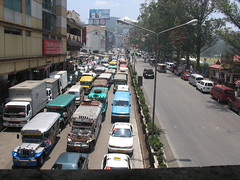
There are more vehicles devoted to taxi work in this country than at home. The morning we got here, we took a taxi from where we live here up the hill to the shop where the telephones were. We have taken taxis just about every day since to get around. It is mainly because having a car here is a luxury whereas at home it's a real necessity. In Canada, unless you live in a metropolitan area like Vancouver or Toronto, the distances we travel every day to get from home to work or anywhere else require owning a vehicle. Here, you don't often have to travel far, and if you do, there are likely to be enough other people going in the same general direction that you can either take a taxi together or take the jeepney.
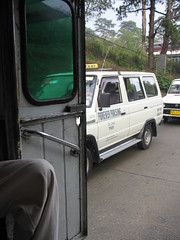
Forever Praising Taxi
Originally uploaded by Allan & Cheryl.
From where we live to get to the market, a journey of about 10 minutes, costs about P45, just over $1 CAD. A longer journey such as going to visit my uncle Peter in Irisan, about 10 minutes outside the city costs around P80, almost $2 CAD.
These prices are reasonable enough for most Filipinos to afford a cab if they are travelling from point to point within the city and have packages to take or are going in group of half a dozen or less.
Compare to rates in Canada where a cab will cost you about a $1 CAD a minute.
Cabs in Canada are used infrequently enough that a cental dispatch is required to ensure that they have enough fares to earn their keep. If a pick-up is not called in, the dispatchers will send cab drivers to locations such as the airport or large hotels where a fare is likely.
Here, no central dispatch is needed because there are pickups everywhere. I don't know how long drivers go between fares, but it can't be very long because the longest we've ever had to wait to wave down a taxi was just under 10 minutes. Even when a driver has a fare that goes out of town, such as the one who took us out to Irisan, he doesn't hesitate because there's a strong likelihood he'll get a fare to take him back into town.
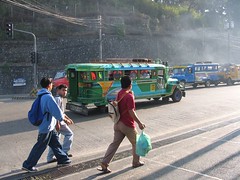
Jeepneys serve the equivalent function of public transit here, except that there isn't an overarching transit authority. Instead they are privately run in an open market fashion. As a system, it works reasonably well.
Compared to taxis, jeepneys are really cheap. It cost ten of us P64 (about $1.20 CAD) to ride home from Tuba town back to Baguio. The trade off is that you have to wait a bit and jeepneys (like buses) follow set routes.
In the Baguio city center, near the market, there are a number of plazas where you can find jeepneys parked. Each plaza is the starting and ending place for one or more regular routes to the different parts of the city and outlying areas. You can walk around the various plazas and listen to the men calling out the routes that start in that plaza.
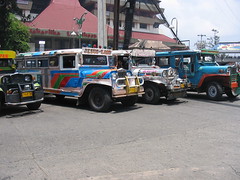
The Philippine Jeepney: Each one uniquely gaudy and a special expression of the Filipino exhuberance for colour.
Originally uploaded by Allan & Cheryl.
If you are with someone who knows the city, they can take you directly to the plaza where you can find a jeepney that goes on a route that will go past the part of the city you are going to. If you don't know the city, you have to ask the men calling the routes.
In that plaza there will be a queue of empty jeepneys waiting. If the route is busy, you may have to wait for a jeepney to return, sometimes full of passengers coming into the city. The man who is calling out the routes will direct you into the jeepney which is first in line for passengers. As soon as the jeepney is full - which can be any time from less than a minute to half an hour - the driver pulls out and the next jeepney in line starts to fill with passengers.
You get into and out of the jeepney from the back, instead of in the front like buses in North America. This means that payments to the driver are done on an honor system. Passengers fish out their coins whenever they can and the fares are handed up to the driver from the back to the front from hand to hand. The driver counts out the fare and any change while he's driving. Any change is returned to the person again from hand to hand.
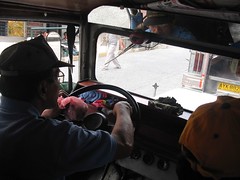
Most drivers use a full width mirror like the one here to see who has boarded and whose fare is being handed forward.
I have no idea what would happen if someone tried to 'stiff' the driver or palm some of the change that was to be handed back to another passenger. In our many rides around town in jeepneys, I've never seen this happen, so I can only imagine that people here take a pretty dim view of this kind of behaviour.
When the jeepney gets close to where you want to get off, you just say, "parah" (pahr-ah) and the driver will stop and let you off. On the inbound part of the route, people will wait by the side of the road and wave at the jeepney driver and he will stop to pick them up.


1 comment:
Oh what fun to ride in a jeepney! The people actually don't mind the bumpy ride; the drivers know how to maneuver their vehicles so they make use of every inch of the road. You just marvel that they don't have many vehicular accidents. Did you try riding the Dangwa bus?
Post a Comment